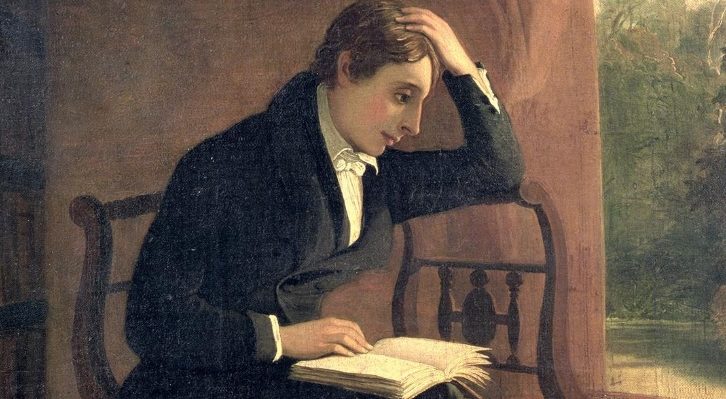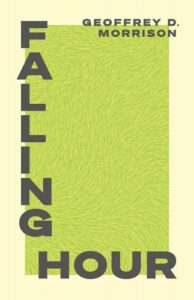
On the Mundane Letters of John Keats
“I cannot manage the cursed Oat Cake” and Other Gems About Nothing
Not long ago, a poem by Diane Seuss appeared in Poetry with the title, “Romantic Poet”:
You would not have loved him,
my friend the scholar
decried. He brushed his teeth,
if at all, with salt. He lied,
and rarely washed
his hair. Wiped his ass
with leaves or with his hand.
The top of his head would have barely
reached your tits. His pits
reeked, as did his deathbed.
But the nightingale, I said.
I love this poem because it says something fundamentally true about John Keats. It conceals neither the spell his words can still cast on us across the centuries, nor the often bratty and sordid young man who made those words, nor the ambivalence that comes from knowing both.
In my debut novel, Falling Hour, protagonist Hugh Dalgarno feels a similar ambivalence towards Keats. Hugh grew up as an autodidact in a working-class home. He has felt “haunted” by Keats ever since he first read about his death in a second-hand magazine as a child, and when he begins to reflect on questions of truth and beauty, birdsong and memory, it is to the letters and incidents of Keats’s life that he looks for some kind of guidance.
Yet, as Hugh also puts it, “I never said I loved the man who haunted me.” Hugh was born in Aberdeen in Scotland, and raised on the west coast of Canada by a great-aunt and great-uncle who emigrated from Aberdeen in the 1970s. He grew up hearing his guardians speaking in Doric, or Northeast Scots, and has a left-wing Scottish nationalist outlook. He is therefore acutely sensitive to the condescension Keats often shows to ordinary rural Scots, especially Gaelic speakers, in his letters from his 1818 excursion to Scotland with Charles Armitage Brown. Hugh at once calls Keats his “enemy” and one whose poems have “served the continuation of [his] life.” “I see no contradiction,” he says. “It may all be put to use.”
In my research for Falling Hour, I inevitably had to read many of Keats’s letters. A number of passages from these letters are justifiably famous and often excerpted. But, in excerpted form, they tend to lose the full, everyday swell of life surrounding the grand declarations—and to my mind the rhythms of that life are just as fascinating. I urge anyone who wants to read the letters in their fullest form to look at Hyder Rollins’ two-volume The Letters of John Keats, 1814-1821, available at many libraries, or, barring that, the selected Letters of John Keats to His Family and Friends, edited by Sidney Colvin and available at Project Gutenberg.
But, in excerpted form, they tend to lose the full, everyday swell of life surrounding the grand declarations—and to my mind the rhythms of that life are just as fascinating.
I also recommend the detailed chronology of Keats’ life compiled by Professor G. Kim Blank at the University of Victoria. In the meantime, here are several passages from letters written in the crucial years of 1818 and 1819, years that Hugh Dalgarno finds so rife with coincidences and premonitions in all their mundane details that he thinks they may reveal a “seam in the universe”
Burns Tourism
When Keats and Charles Brown went to Scotland in the summer of 1818, they did so partly as literary pilgrims to sites associated with Robert Burns. I find Keats’ Burns-worship an odd thing. Because Burns was dead, Keats could make him his own, which pointedly meant de-Scoticizing him: “poor unfortunate fellow, his disposition was Southern,” Keats writes to his brother Tom on July 6th, distancing Burns from the country and the people who taught him the songs and stories he would later make so famous. On July 13th, Keats wrote an account of visiting Burns’ birthplace for his friend John Hamilton Reynolds. It is also telling in this regard:
We went to the Cottage and took some Whisky. I wrote a sonnet for the mere sake of writing some lines under the roof—they are so bad I cannot transcribe them—The Man at the Cottage was a great Bore with his Anecdotes—I hate the rascal—his Life consists in fuzz, fuzzy, fuzziest—He drinks glasses five for the Quarter and twelve for the hour—he is a mahogany-faced old Jackass who knew Burns—He ought to have been kicked for having spoken to him. He calls himself ‘a curious old Bitch’—but he is a flat old dog—I should like to employ Caliph Vathek to kick him. O the flummery of a birthplace! Cant! Cant! Cant!
Maybe he was a jackass. But Burns would not be Burns without the storytelling, whisky-drinking “rascals” he grew up with in Ayrshire, and I think it is too bad that Keats couldn’t see that.
Oats, Pipes, Gaels
Elsewhere in his letters from Scotland, Keats plays the part of the unpleasable Englishman abroad to the hilt. The following are a just a selection of his complaints:
Inverary, July 18, to Tom, after listening to a band play:
“I must say I enjoyed two or three common tunes—but nothing could stifle the horrors of a solo on the Bag-pipe—I thought the Beast would never have done.—Yet was I doomed to hear another.”
Kilmelfort, July 20, to Tom, after hearing people speak Gaelic for the first time:
“I am for the first time in a country where a foreign Language is spoken—they gabble away Gaelic at a vast rate… Last night some Whisky Men sat up clattering Gaelic till I am sure one o’Clock to our great annoyance.”
Oban, July 21, to Tom, in a complaint about the food:
“I cannot manage the cursed Oat Cake.”
Doing Nothing in Early 1819
Keats’ precocious career can sometimes feel like an envy-inducing supernova of youthful energy. He seems to have done so much, and so well, in so little time. So it should perhaps be some comfort to everyone that he spent the first quarter of his “Annus Mirabilis” in 1819 doing very little mirabilis-ing. The chronologies assembled by Hyder Rollins and G. Kim Blank tell us that he ran errands and socialized often (he even went out dancing four times) but hardly wrote for most of the period from January to March. In a March 8th letter to his friend Benjamin Robert Haydon, he says,
“You must be wondering where I am and what I am about! I am mostly at Hampstead, and about nothing…not exactly on the road to an epic poem.”
I think there’s a lesson here about the somethings that sometimes come from “nothing.”
The Velocipede
Keats’s brother George and sister-in-law Georgianna (I know, that pairing is goofy as hell) emigrated to the United States in 1818. In America they missed out on the latest London fashions, including an early forerunner of the bicycle variously known as a vélocipède, draisienne, hobby-horse, or dandy horse—essentially a bike with no pedals. Keats gives the couple the rundown on the 17th of March, 1819:
“The nothing of the day is a machine called the velocipede. It is a wheel carriage to ride cock-horse upon, sitting astride and pushing it along with the toes, a rudder wheel in hand—they will go seven miles an hour—A handsome gelding will come to eight guineas; however they will soon be cheaper, unless the army takes to them. I look back upon the last month, I find nothing to write about; indeed I do not recollect anything particular in it. It’s all alike; we keep on breathing.”
It’s not clear if Keats ever got a chance to ride one himself. I also note the poignancy of “we keep on breathing” as stated by someone whose brother died of tuberculosis the previous December and who would do so himself in a little under two years.
The Cricket Ball
On Thursday, the 18th of March, 1819, after weeks and weeks of mostly doing nothing, John Keats was hit in the eye by a cricket ball. He writes about it to George and Georgianna the next day:
“Yesterday I got a black eye—the first time I took a cricket bat—Brown who is always one’s friend in a disaster applied a leech to the eyelid, and there is no inflammation this morning though the ball hit me directly on the sight—it was a white ball…”
The accident was lucky, in a way. To ease his pain, Keats seems to have taken a tincture of laudanum. At very least, he writes like he did:
“This morning I am in a sort of temper indolent and supremely careless: I long after a stanza or two of Thompson’s Castle of indolence—my passions are all asleep from my having slumbered till nearly eleven and and weakened the animal fibre all over me to a delightful sensation about three degrees on this side of faintness—if I had teeth of pearl and breath of lilies I should call it langour—but as I am I must call it Laziness…”
Further into the letter, he claims to be so relaxed that “Neither Poetry, no Ambition, nor Love have any alertness of countenance as they pass by me: they seem rather like three figures on a greek vase…” So, in this letter alone, we have both “indolence” and “a greek vase” as themes. Within a couple of months, he would write his six most famous odes, including “Ode on Indolence” and “Ode on a Grecian Urn.” Would he have written them without the psychic shakeup of getting hit by a cricket ball and recovering with opium? Probably. But it surely didn’t hurt—except, of course, when it did.
_________________________

Geoffrey D. Morrison’s Falling Hour is available now from Coach House Books.
Geoffrey D. Morrison
Geoffrey D. Morrison is author of the poetry chapbook Blood-Brain Barrier and coauthor of the experimental short fiction collection Archaic Torso of Gumby. His debut novel, Falling Hour, is out now from Coach House Books. He lives on unceded Squamish, Musqueam, and Tsleil-Waututh territory.



















